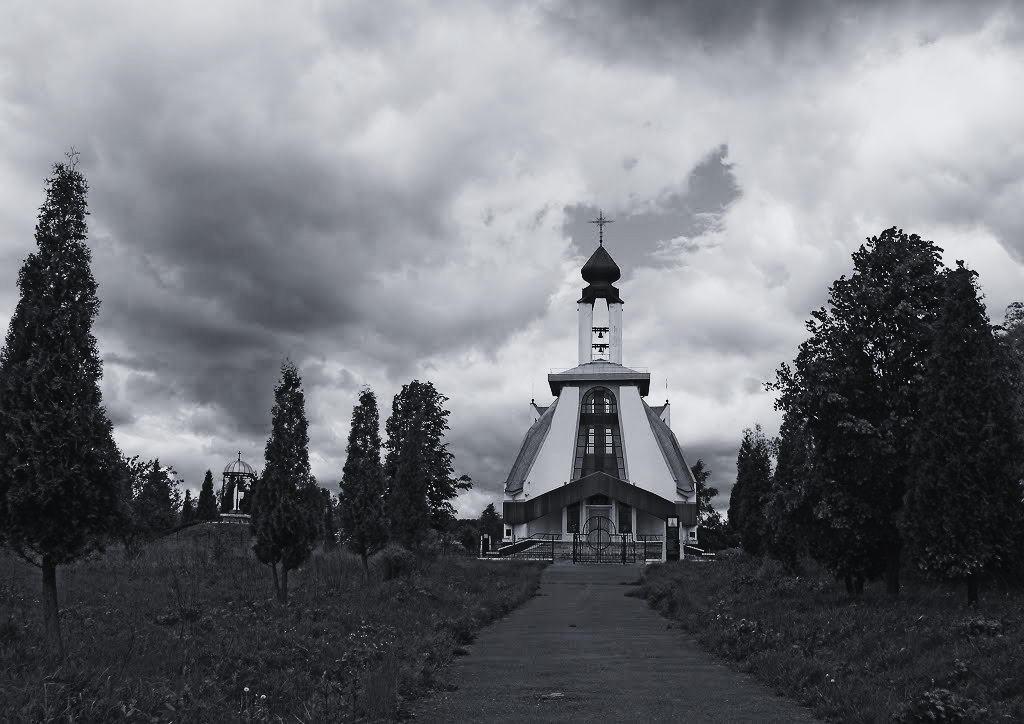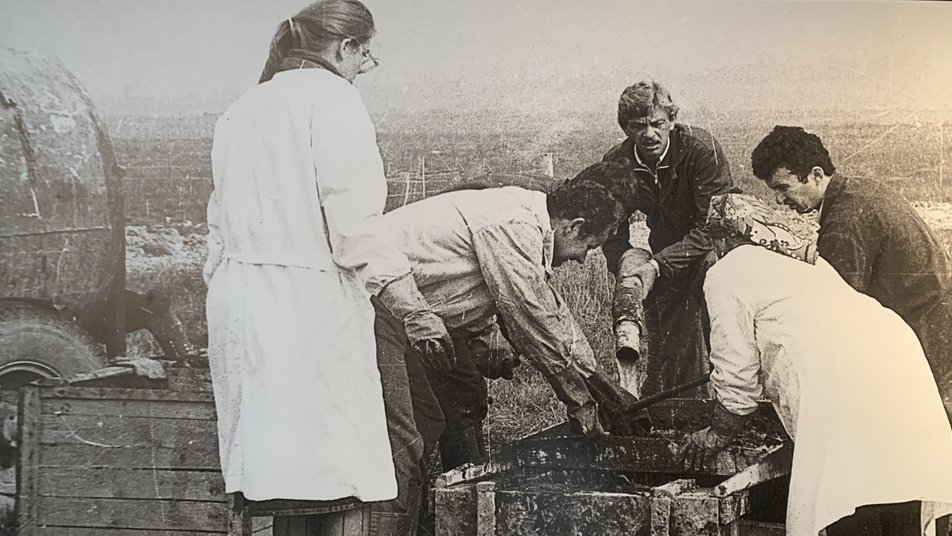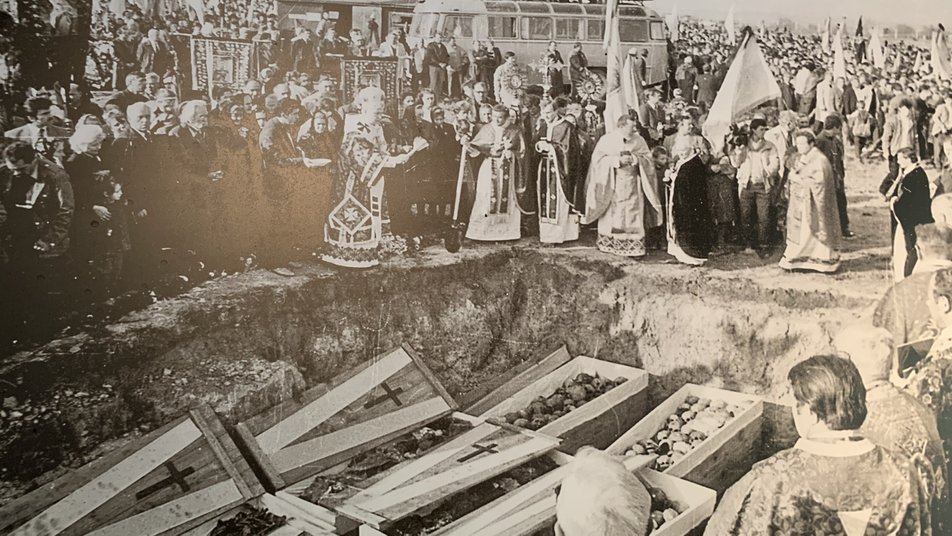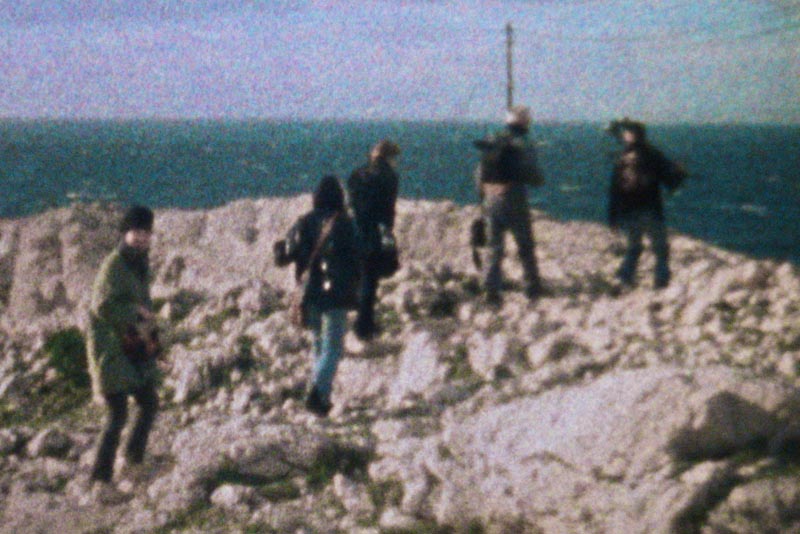
Vasyl Tymkiv is the director of the Pamiat Utility Enterprise of the Ivano-Frankivsk Regional Council for the search and reburial of victims of wars, repressions, and deportations of totalitarian regimes and the head of the “Memorial” Non-Governmental Organization, which has been searching for mass graves of victims of communist terror since the 1980s.
We talked with him about how in the late 1980s in Ivano-Frankivsk they found Demianiv Laz, the place of mass burials of Ukrainians shot by the Bolsheviks.
In 1998, a church was built next to the place of mass burials. And in 2009, a museum was arranged in its basement. This complex is an example of a successful implementation of commemorative practices and honoring the memory of people whose burials were found, that is, what Ukrainians, unfortunately, face again during the full-scale phase of the war with that same empire.
Warning: the text contains descriptions of exhumation.
Could you tell the story of Demianiv Laz and its historical context, and how the excavations began?
In 1988, when the Soviet Union was still hiding its crimes in every possible way, there was talk of Kuropaty in Belarus, where mass graves of Soviet terror were found. Back then, the “Memorial” International Organization spread throughout the territory of the Union, and there was founded a branch in Ivano-Frankivsk, which was headed by Zinovii Duma.
The then old residents of the village of Pasichna remembered how at the end of June 1941, the NKVD representatives (People’s Commissars for Internal Affairs) took bodies of people on trucks to the woods on the outskirts of the village. Eyewitnesses recalled that blood was dripping from the tarpaulin-covered cars. These were dead prisoners of Soviet prisons who were mass-murdered before the arrival of Nazi troops in the city. When the Germans were already in Stanislaviv in July 1941, they tried to uncover the crimes of the Soviet authorities: in the prisons in Sakharov Street and in the fifth school, the NKVD left more than 700 bodies of murdered prisoners, which the Germans buried near the Promprylad plant (at that time it was the edge of the city cemetery). At the same time, the Germans also dug up the mass grave in Demianiv Laz, which many people from the surrounding villages came to see. But it was quickly buried back because of the fear of epidemics.
From Petro Vintoniak’s testimony:
“I was plowing my field on the side of the mountain that faces the village of Zahvizdia. It is right across from Demianiv Laz. During the day, while I was plowing, I heard frequent shots from that forest. (…) No one was allowed to Demianiv Laz, where they seemed to be preparing warehouses for ammunition. During the night, I saw tarpaulin-covered trucks driving one by one to Demianiv Laz. I know where the guards stood, who did not let anyone into the forest. For several days, the residents of Pasichna heard gunshots echoing from the forest. All old and young people know about it. Almost the whole village went to see when the Germans were excavating. I went too. Two pits out of three were opened. I looked into one and saw men in vests. I did not approach the second pit, there was nothing to breathe, and the heat and the smell made me dizzy.”
From Bohdan Vintoniak’s testimony:
“For three days, a tractor hummed in Demianiv Laz, and people were shot under its noise. Shot prisoners from the Stanislav prison were also brought to the forest. My house is on the road to Demianiv Laz. So every morning I saw that the whole narrow road was sprinkled with blood. (…) A group of people, brought by the Germans to Demianiv Laz, had to open graves and pull out the dead from them. I couldn’t look at it. Such a large number of corpses together, decomposing, created a so-called dark red pus under them. After the partial exhumation of the human bodies, the graves were closed and crosses were dug into them. When I returned from the war, there were no crosses on the graves. There were no graves. This shows that the NKVD representatives, returning to Stanislav after the departure of the Germans, immediately began to erase their criminal traces.”
As early as 1969, after information about burials in Demianiv Laz appeared on the air of “Voice of America”, the Soviets used bulldozers to uproot all forest plantations in the tract, as they themselves explained, in order to expand collective farm fields. Therefore, in 1989, when “Memorial” began to search for graves, it was difficult for the old residents to find their way around the territory of Demianiv Laz, and the search continued throughout the summer. Already on September 21, when the grass had turned yellow, the attention of one of the searchers was drawn to a still green hilly place: the plants were drawing juices from the bodies of the mass burial.

From the archives of the Demianiv Laz Memorial Complex / Suspilne
Зі свідчень Ольги Богун:
«Взимку 1941 року мені виповнилось 10 років. Ще з зими попри нашу хату часто їздили машини в ліс, який починався за селом. Особливо багато їх стало на початку літа. То були вантажні машини, криті брезентом. І їздили вони переважно вночі. У той час жителям нашої вулиці навіть не дозволяли виходити з хат. Якось увечері до нас повернув військовий. Він наказав загасити каганець і лягати спати. Так ми жили й не відали, що творилося поруч. Дітей, які пасли худобу під лісом, військові відганяли. Ніхто туди не мав доступу. Вже при німцях ми довідалися, що в лісі є кілька могил. Про те було опубліковано в газеті, а ми, діти, першими прибігли подивитися, що там розкопують. Того я не забуду, скільки житиму. Першою відкопали жінку з дитиною на руці. Вона і після смерті притискала немовля до грудей. Могила була глибокою, так що жінку тягнули з трудом. Пам’ятаю, що вона була в гуцульському кептарі, однак лиця її вже неможливо було розпізнати. Дітьми ми часто пасли худобу в тих місцях. Я бачила, як ті могили запалися і на їх місці виступили чорні маслянисті плями. А потім все заросло травою, кущами».
What was the reaction to the findings from the city authorities, among the community?
The then Soviet authorities warned: if nothing is found, you will receive an article for slandering the authorities. But when they were found, it was still necessary to prove that the buried were victims of the Soviet regime – the party members insisted that they were prisoners shot by Nazi soldiers, or murders committed by Bandera people. However, thanks to the medical examination of Omelyan Levytskyi, it was possible to prove that people were killed by Enkavedists. Incontrovertible evidence was found on thirty bodies: prison receipts and even prison sentences, among which none were fatal, with the words “USSR, People’s Commissariat of Internal Affairs”.
Зі спогадів директора київського Музею радянської окупації Романа Круцика, який у 1989 році брав участь у пошуках поховань в Демʼяновому Лазу:
«…У той час до нас приїхав завідувач адміністративного відділу обкому КПУ, заступник голови комісії Валентин Карпенко. “Високий гість” подивився на нашу роботу і скептично, вказуючи пальцем на мене, сказав: “Ну смотри, если ничего не найдете, то за сплетни на советскую власть десятку получишь”. Ці слова, сказані у присутності багатьох людей, в той же день викликали поголос по Пасічній, що Карпенко обіцяв запроторити мене в тюрму на 10 років за наклеп на радянську владу. Збентежені заявою “високого гостя” та майже двогодинними марними пошуками могил, ми в якомусь заціпенінні дивилися один на одного (…)».
«…Я попросив екскаваторника черпнути ще раз. І тоді ківш витяг залишки одежі, а з ними й людські кості. Ми ще не вірили, що знайдено могилу. Я скочив у яму, закотив рукав сорочки і почав намацувати у воді. Всюди намацував людські кості. Вибрався з ями, відійшов від людей, бо раптом відчув у всьому тілі неймовірну втому. Жаль і ненависть розпирали груди. То була якась страшна душевна мука, заціпеніння. Підвів очі до неба, щоб заспокоїтись. Так тривало кільканадцять секунд. І неймовірна напруга в тілі почала спадати».
The discovery caused an explosion in society: members of the Communist Party tore up their party tickets over the grave, an unheard-of act of dissent at the time. And on October 30, 1989, the remains of the tortured were reburied — about 300,000 people gathered independently in Demianiv Laz.

From the archive of the Demianiv Laz Memorial Complex / Suspilne
Did the authorities then officially recognize the tragedy of Demianiv Laz?
A criminal case was officially opened against Enkavedists who worked in Stanislavov prisons in June 1941. Members of “Memorial” even tried to find them.
Зі спогадів старшого слідчого обласної прокуратури Миколи Даниліва:
«…Виявлене було страшним. Сумніву, що тут поховані розстріляні люди, уже не було ні в кого. Тисячі кісток, зотліла одежа, кулі, знайдені в захованнях, гребінці, ґудзики, дерев’яні ложки, документи свідчили про вчинений злочин.
(…) Наступного дня на місце поховання прибула «висока» партійна комісія, яка стверджувала, що розстріли вчинені бандерівцями або ж німцями, що відступали. Яке розчарування було в них, коли в зітлілій одежі виявився документ — копія вироку на Мишковського, виписана на бланку НКВС. З архівів КДБ витребувано кримінальну справу Мишковського, яка підтвердила вчинення злочину «визволителями». Мишковський розстріляний незаконно, без відповідного вироку суду. Пізніше було виявлено ще два поховання, в яких знайдено копії вироків, протоколи обшуків, різноманітні квитанції з атрибутикою НКВС. Після проведення експертних досліджень встановили й прізвища нещасних. (…)
Під час розкопок в одному із поховань були виявлені ґудзики від солдатської шинелі з п’ятикутними зірками. Про це одразу стало відомо в обкомі КПУ. Знову стали мусувати версію про непричетність військ НКВС до злочину у Дем’яновому Лазі. Нас, мене та ініціаторів розкопок, зібрали на засідання комісії, яку також було створено обкомом КПУ невідомо навіщо. Адже розслідувалась кримінальна справа, і тільки слідство повинно було встановити істину. Слідство і встановило, що особа в солдатській шинелі теж розстріляна НКВС. Сумнівів у скоєнні злочинів — незаконних убивств наших людей комуністичною системою — не виникало ні в кого».
But the most important thing is that the excavations in Demianiv Laz gave impetus to further searches for mass graves of victims of totalitarian regimes [in Frankiv region]. Thus, in 1990, a grave was found in the village of Posich with more than ten bodies, identified by their clothing as Greek Catholic priests. The heads were dismembered and wrapped in sackcloth. The medical examiner found out that people were tied to a tree by their legs, and nooses were put on their heads: they separated their heads from their bodies with the movement of the car. It was a particularly brutal death. A total of 36 found victims from Posich were reburied in Demianiv Laz.
Зі спогадів Романа Круцика:
«(…) Слідчий Лобащук підписував протокол останнім. Він ще раз вголос прочитав його, зупинився в тому місці, де говорилося про відрізані голови, підписав протокол, а потім вийняв із кишені свого партійного квитка, розірвав його на кілька частин і викинув у розриту могилу».
In the late 1990s, interest in finding mass graves waned, although not all of them were found. The last memorial excavations under the leadership of Ivan Pavlykivskyi took place in 1999 near Primary School No. 5 in Ivano-Frankivsk, where more than ten tortured people were found. The burial was disguised as a public toilet by the Soviet authorities, who used the premises of the fifth and seventh schools as a place of detention for prisoners until the late 1950s.
What is the modern role of the Demianiv Laz complex?
Those who enter “Demianiv Laz” for the first time have a strong emotional impression. If the visitor did not know about the tragic fate of many Ukrainians under the “Soviets” before, then after that people will understand: that’s how it was, and this is the true history of the Ukrainian people. In addition, “Demianiv Laz” is a unique museum complex, the like of which does not exist in the west of Ukraine. It should become a must-see for us, like Auschwitz for the Jews.
Because the Soviet communist regime exceeded the terror of Nazi Germany ten times. On the territory of the Soviet Union with a population of 200 million, there were more than 5 thousand camps and prisons where millions of people were tortured and killed. In Ukraine during the Soviet Union, virtually every district center was a place of terror. So, in 2019, in Bilshivtsi, we excavated the burials of 59 people near the building of the music school, which served as a place of imprisonment – the engraved inscriptions of the prisoners are still preserved on the walls.
But, unfortunately, the world community still does not understand what needs to be condemned, or at least begin the process of recognizing and condemning the Soviet terrorist regime, which was reborn into modern Russia.
Are there other places in Frankivsk or in the region – with burials found or places that still need to be researched – that need the same public attention as Demianiv Laz?
You have to look further in the village of Posich. After all, Enkavedists chose villages with forests nearby for burials, and they were especially attracted to areas with hollows in the ground. And there were a lot of trenches in Posich after the First World War – ideal places for burials for “Soviets”. According to the testimony of eyewitnesses, Enkavedists took the murdered there throughout the 1940s.
In Ivano-Frankivsk itself there are places that need research. Thus, according to the testimony of eyewitnesses, Enkavedists also carried out similar mass burials at the cemetery on Kyivska Street. However, the boundaries of the cemetery have changed. According to our data, these places are now built up by an industrial zone, or occupied by new burials from the 1970s.
Why is it important for you to continue searching for mass graves of victims of totalitarianism?
When I became a member of “Memorial” in 2008, I could not understand why the search stopped. It was important for me that the memory of the victims of communist terror should not be lost.
The leitmotif of my life is to announce to the entire Ukrainian nation that Moscow has not repented of any of its crimes against humanity, and we cannot forget it under any circumstances. At least at the local level, they would raise this topic by finding more burials, and with them, evidence of Soviet terror. Although this is highly specialized work, it is one of the determining factors in the formation of national memory and cultural policy.
But every year it becomes more and more difficult to work, because there are fewer and fewer witnesses of those events. And the testimony of eyewitnesses is the main source of information, because the Soviet authorities did not archive the places of burials and executions.
Today, especially my soul and consciousness are tormented by the question: have I done enough? Because when Bucha and Irpin were revealed, I saw the same terrible “work” of the executioners, as it was in Demianiv Laz. I hope that current events will force the world to understand irrevocably: unpunished evil returns and multiplies.
What are you working on now?
This year we are conducting only search operations, without exhumations. In addition to finding victims of political repressions, we also find burials of the First and Second World Wars. Yes, we are currently implementing a grant project together with the Slovakian government to restore cemeteries where Ukrainian and Slovak soldiers who served together in the same regiments are buried. Two such cemeteries are located in the village of Pavlivka, one of which needs exhumation and proper reburial due to numerous destructions. In general, we have a lot of work to do with World War I burials.
Why it is important to restore and preserve World War I burials?
The First World War affected our region very much. Thousands of Ukrainians fought as part of the Austrian army, from which over time the Ukrainian Sich Riflemen and the Ukrainian Galician Army were formed. In addition, the participation of Ukrainians in the First World War unites us with Europe, which equally honors the fallen soldiers in the two world wars. Because preserving the memory of these important events cements and creates a nation.
What do you do with the burials of soldiers who fought against us – Hungarians, Poles, Austrians, Germans?
We carry out the process of memorialization: we restore the cemeteries and graves of these soldiers, which were often neglected and lost during the Soviet rule. In addition, we work with digitized lists of these soldiers and know by name who was buried where. A respectful attitude towards such graves shapes our face in front of European states as a country that remembers and respects the past.
Why is it important to do reburials if we can’t tell whose grave it is?
First, people are not buried in such graves. Throwing them into a common pit is not a Christian burial process. And human morality and religion show that it is necessary to treat human remains with respect, especially those who have been murdered.
Secondly, even if we do not know the names of the buried, by opening these graves, we are once again teasing the public memory, not letting it be forgotten. Knowing the number of people killed and the nature of the terror, we confirm the crimes of the Soviet authorities. Knowing that they killed Ukrainian women and children who did not pose a threat to the authorities, we prove that the communists carried out a targeted genocide against the Ukrainian people. And mass burials are evidence of an act of genocide.
P.S.
From the fall of 1939 to the fall of 1940, the Soviet authorities repressed about 10% of the population of Galicia — more than one million one hundred thousand people.
Excavations in Demianiv Laz lasted from September 21 to October 29, 1989. The remains of 524 killed were reburied in 33 houses. Thanks to the found documents and the testimony of relatives, it was possible to establish the names and surnames of 22 victims. Work in the archives of the SBU made it possible to determine the names of another 400. The investigation also established the names of 9 executioners from the local NKVD
Усі цитати наведені за книжкою Романа Круцика «Демʼянів лаз. Геноцид Галичини»




